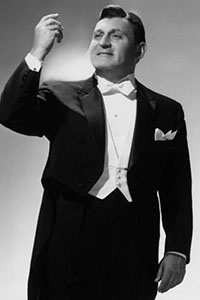Richard Tucker - History of The Tenor (original) (raw)
Richard Tucker
Richard Tucker
The History of The Tenor Narrated
The History of Richard Tucker

Born: August 28, 1913
Died: January 8, 1975
American tenor.
Narrative 1
The last American tenors we heard were Richard Crooks and Charles Kullman. Both born at the beginning of the century.
The next luminary from the United States was to be Richard Tucker, born Rueben Ticker in Brooklyn on 28th of August 1913.
He studied with an older American tenor Paul Arthouse. And after a spell in business, began his local career in synagogues and on the radio.
America in general and the metropolitan, were to be the focal point of his extraordinary career, which spanned three decades of leading roles. And frequently brought him public comparisons with Caruso, even from Gronow Bing.
He sang thirty leading roles in three languages, at the Metropolitan. First lyric and later dramatic. Beginning in La Giaconda, on the 21st of January 1945 and ending with Pagliacci, just a few weeks before he died on the 8th of January 1975.
Here he is singing Apri La Tua Finestra from Mascagni’s opera, Iris.
Narrative 2
Tucker was, like Rosa Ponselle, quite content to stay at Metropolitan. And did not travel abroad a great deal.
He made his European debut in 1947, at the Verona arena as Enzo to Maria Callas’, Giaconda. This being the great Sopranos Italian debut.
He also made appearances in Vienna, Buenos Aires, Barcelona, Florence, and sporadically in London, starting there in 1958, as Cavaradossi in Tosca.
However, in America, he sang with all the major companies, most of the leading orchestras and was a popular recitalist.
For our next record, we hear an Aria from Verde’s, un Ballo Masquera, Di Tu Se Fedele.
Narrative 3
Tucker’s singing was never noticeable for finesse.
You could hardly find anyone so different from Tagliavini, whom we have just heard. And he was born in the same year.
His acting, though energetic, remained primitive. But he had few peers, in the projection of Italian passions, or in verva, ease, evenness and vocal security.
He was a deeply religious man and some time, canta, and his wish to sing La Juieve, The Jew, at the metropolitan remain unfulfilled.
Though he did undertake the role elsewhere.
Writing about him in the grand tradition, John Steane compares the 1955 recording of Force of Destiny with Callas, to the 1965 version with Leontime Price.
Ten years later he had reduced the sobs, and wrote two key insenno, this is an achievement, for in the first version, virtually every phrase had its sob, and the ideos were heavy with tears and aspirates.
Now both have gone, and the voice has stayed. If a listener were told that the two recordings were made within a fortnight of each other, he might doubt, on the grounds, that the style of singing and the quality of recording were different.
But against this, he would accept the fact, that the voice was virtually unchanged.
Yet at the time of that second recording, Tucker was in his 50s, an age when few heroic tenors sound quite their young selves.
Here then, is the 1965 O Tu Ki In Seno refer to.
And then to conclude, a brisk jet of Price from the same set.